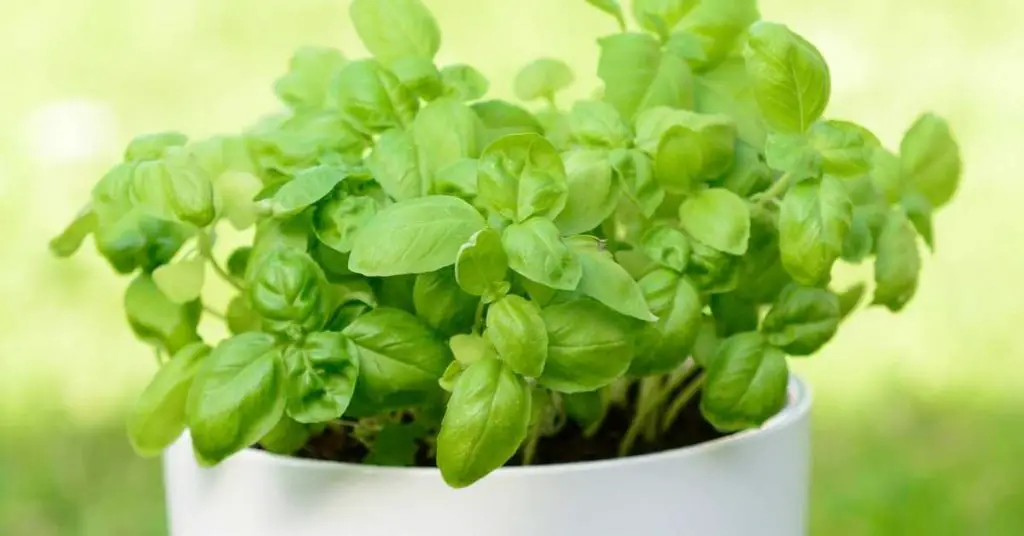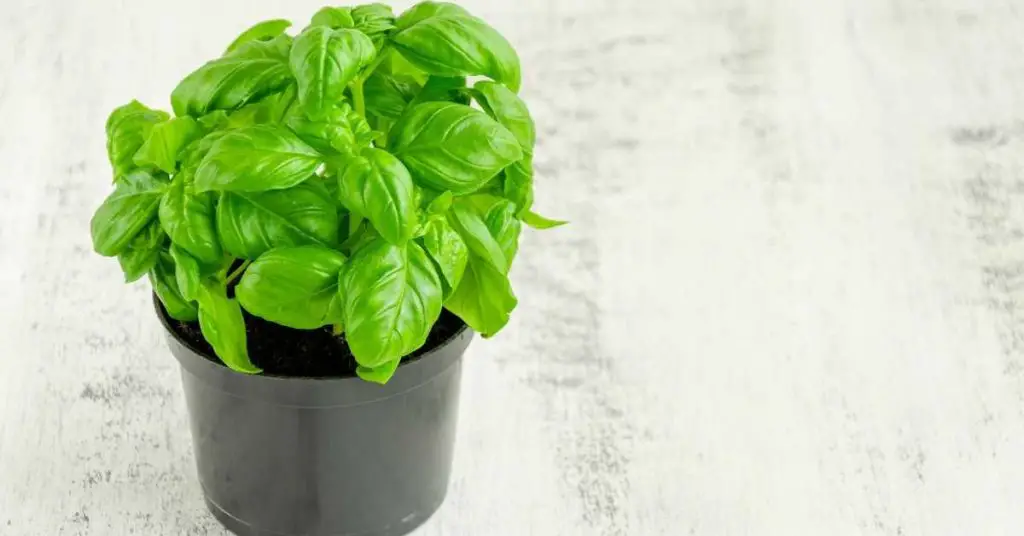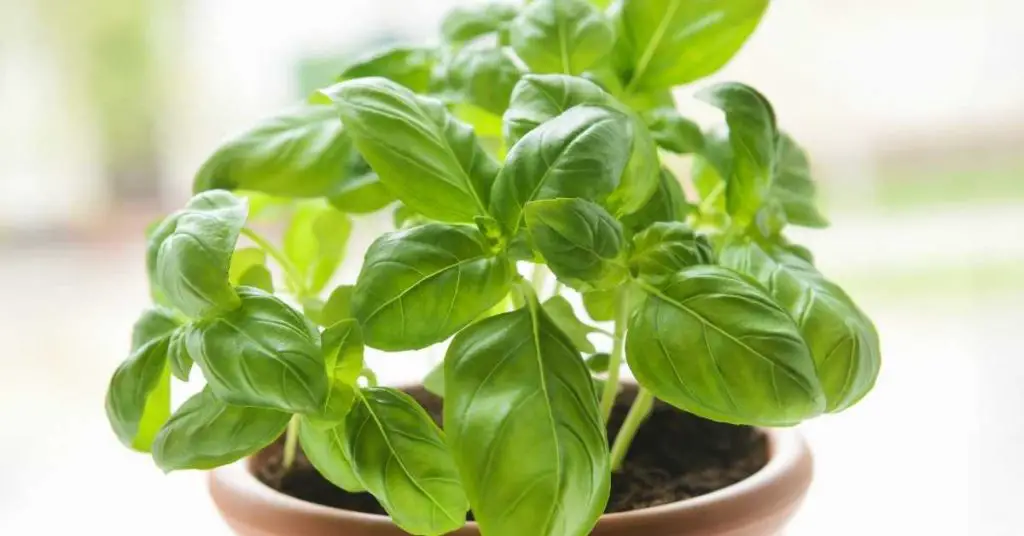How To Grow Basil In a Pot
How to grow basil in a pot? The simplest way to grow basil in a pot is to fill up a 2-3 gallon pot at the smallest with good quality potting mix, pre-moisten the potting mix and plant your seeds or plant directly into the potting mix. Keep the pot moist but not saturated until your seeds sprout. Once your plant is about 10 inches tall start harvesting fresh leaves from the basil plant to use in your cooking. Harvest leaves weekly to encourage new growth on your plant. Keep it watered and fertilize once every 7-10 days, keep harvesting, and if you see flowers starting to form, just pinch or cut the plant back to prolong the harvest.
Basil is a great herb to grow in a pot. It’s easy to care for and you can use it in many recipes. In this blog post, we’ll share how to grow basil in a pot so that you can enjoy this delicious herb all year round. Stay tuned for our tips on keeping your basil plants healthy and happy!
How To Grow Basil in a Pot
When it comes to growing basil in pots, it really comes down to a system. Basil is a herb that has to have sun, water, and regular harvesting in order to thrive. If you can provide the basil with these things – then you can grow basil in pots and be successful.

Why Is It so Hard to Grow Basil?
One reason for this is that basil is very sensitive to temperature changes. If the temperature drops too low, the leaves will turn black and the plant will die. Conversely, if the temperature gets too high, the leaves will start to turn yellow. As a result, it can be difficult to find a happy medium when growing basil.
The other reason why basil is so difficult to grow is that it requires a lot of water. The soil must be kept moist at all times, otherwise, the leaves will start to curl and the plant will eventually die.
For this reason, basil is best grown with consistent moisture levels either by using drip irrigation or by making sure to keep a watering schedule when manually watering.
What Variety of Basil Does Best in A Pot?
There are many different varieties of basil, but not all of them will do well in a pot. The best type of basil for growing in a pot is sweet basil. This variety is more resistant to temperature changes and can tolerate some drought.
Other types of basil that can be grown in a pot include:
- Lemon Basil: A citrusy-smelling herb that does best in partial sun.
- Sweet Basil: The classic variety that is great in Caprese salad.
- Purple Basil: A beautiful, deep purple color with a milder flavor.
- Greek Basil: A small leaf variety that is used in Greek cuisine.
- Spicy Globe Basil: An unique variety of basil that grows in a small footprint perfect for a pot.

What Size Pot Should I Use to Grow Basil?
The best size pot for basil would be at least 2 or 3 gallons. Do not think of this as an absolute criterion for growing basil as I have grown it in smaller and larger containers. The main thing to keep in mind is to provide the best growing conditions for basil to thrive.
A 2 or 3-gallon pot is a great place to start if you already have those around. But, you can certainly grow a basil plant in a 1-gallon pot if you care for it the right way and you can grow multiple basil plants in a 10-gallon grow bag or pot if you want more leaves to eat.
How Much Basil Should I Grow?
This really depends on how much basil you use in your cooking. A single plant can provide a lot of leaves if you only use it occasionally. If you love to cook with basil and want to have it on hand all the time, then you might want to grow 2 or 3 plants.
How to Plant Basil in A Pot
The best way to plant basil in a pot is to start with a young plant from a nursery or by starting seeds indoors 6-8 weeks before your last frost date.
Growing Basil from Seed
If you want to start basil from seed, it’s best to do so indoors. This way, you can control the temperature and moisture levels that the seeds are exposed to.
Start by planting the seeds in a seed-starting mix in a tray or pot. Then, place the tray or pot in a warm spot (around 70 degrees Fahrenheit).
Keep the soil moist but not saturated and wait for the seeds to germinate, which should happen within 7-10 days.
Once the seeds have germinated, move them to a sunny spot and continue to water as needed. When they reach about 6 inches tall, thin them out so that only the strongest plants remain.
Related: Best Herbs to Grow in your Garden
Buying Transplants
You can also buy basil seedlings at your locally owned nursery, big box store, or even a supermarket that you can take home and plant into your pot or garden. These plants are started in a greenhouse or high tunnel early enough that they are ready to go into your garden when it is time.
The only thing about buying transplants is costs more than starting your own seed. One packet of seed is typical $2-3 and will have 100-300 seeds in it whereas one plant will cost between $3-6.
Regardless if you started your own seeds or if you bought transplants from a local shop, you are can plant them in your pot when they are ready.
How to Transplant Basil Seedlings
When it comes time to plant, make sure you are using a high-quality potting mix and not garden soil. Garden soil will be too dense and will not drain properly, leading to waterlogged roots and eventual root rot.
Fill your pot about 75% up with potting mix and then water it thoroughly until water starts to come out of the drainage holes. This will help settle the potting mix and get rid of any air pockets that could dry out the roots.
To plant your basil, dig a hole that is twice the width of the root ball and just as deep. Gently remove the plant from its container and place it in the hole. Backfill with potting mix, water well, and then mulch around the base of the plant to help retain moisture.
How to Care for Basil Plants in A Pot
Once your basil plant is in the ground, it is important to keep an eye on it and make sure it is getting enough sun, water, and nutrients.
How Much Sunlight Does Basil Need?
Basil plants need at least 6 hours of direct sunlight each day, so make sure to place them in a spot that gets plenty of sun. If you live in an area with hot summers, you may need to provide some afternoon shade to prevent the leaves from scorching.
Do Basil Plants Need Full Sun?
Basil grows its best when the temperatures are warm and when it is grown in an area of your garden that gets “full sun”. In the gardening world, full sun means at least 6-8 hours of sunlight. This can be morning sun, afternoon sun, or a combination of the two.
However, if you are in an area that reaches extreme temperatures during the summer, it will be best to grow in a spot that gets morning sun and afternoon shade.
What Does Basil Look Like when It Doesn’t Get Enough Sun?
The tell-tale sign of a basil plant that isn’t getting enough sun will be a tall, spindly plant that has fewer leaves. The leaves the plant does have will often turn yellow or brown as a result of lack of light.
Can Basil Get Too Much Sun?
Yes, basil can get too much sun. If the leaves start to turn yellow or brown, it is a sign that the plant is getting too much heat and needs to be moved to a shadier spot. Try putting your basil pot into a spot in your yard that gets early morning sun and afternoon shade or you can just move the pot when it starts to get too hot.
How Often Should I Water My Basil Plant?
Basil plants need to be kept moist at all times. The best way to do this is to water them deeply and regularly, making sure the soil never dries out completely.
If you are using a pot that does not have drainage holes, be careful not to overwater as this can lead to root rot. Allow the top inch of soil to dry out before watering again.
You can use a drip irrigation system to water your pots on a timer or use a soil moisture meter to know when to water them by hand.
Related: Drip Irrigation Systems: The Ultimate Guide
How Much Fertilizer Does Basil Need?
You should fertilize your basil plants every 2-3 weeks using a half-strength balanced water-soluble fertilizer to keep them healthy and growing. This could be a fish emulsion, seaweed, or even something like Agro Thrive water-soluble fertilizer.
You can also use worm castings or worm tea to fertilize your basil plants every couple of weeks.
Related: Are Worm Castings Good Fertilizer
When Should I Harvest Basil?
You can start harvesting basil leaves as soon as the plant has a few sets of true leaves. You want to make sure that your basil plant has several sets of true leaves that have grown to full size to ensure the plant will keep producing leaves.
If you harvest too early, the plant will be stunted and produce fewer leaves. However, if you wait too long, the leaves will become tough and bitter. The best time to harvest basil is when the plant is 6-8 inches tall and has plenty of lush, green leaves. At this point, the leaves will be tender and full of flavor.
How to Harvest Basil Leaves
When it comes to harvesting basil you want to pick the leaves that have been on the plant the longest while still picking the smallest leaves that still look good. To harvest, simply snip off the leaves you need with a sharp pair of scissors, making sure to leave at least 2-3 sets of leaves on the plant so it can continue to grow.
Trim away leaves that are discolored or have insect damage as you want to harvest leaves that are good.

Where Do You Pinch Basil?
The idea of pinching simply means pinching the stem back to promote further growth in the plant which will give you more leaves to harvest. You pinch the top of the stem at different times to encourage side stems that will each produce new leaves to eat.
You should also pinch by flower stalks, in the same way, to prolong the harvest period as the plant will produce more stems in order to produce another flower spike. Keep pinching back the basil until you are ready to let the plant go to flower.
Should I Pick Basil from The Top or Bottom?
It depends on when you are picking the leaves of the plant. It is best to pick your basil leaves from the top of the plant as harvesting from this part of the plant will cause the basil plant to produce more leaves.
This might seem counterproductive as the oldest leaves are at the bottom of the plant but if you harvest the oldest leaves first the plant will continue to grow taller and taller. Thus, resulting in a taller plant but with less harvestable leaves.
How Do You Pick Basil so It Keeps Growing?
When you are ready to harvest your basil, cut the stem about an inch or two above a set of leaves. This will encourage new growth and more leaves for you to enjoy! You can also top your basil plant to encourage new side stems that will produce more leaves for you to pick in the coming weeks.
How Often Should I Harvest Basil?
It depends on a few factors, including the size of the plant and the time of year. In general, it’s best to wait until the plant has at least six leaves before harvesting. This will give the plant time to recover from the removal of the leaves and produce new growth.
If you wait too long to harvest, the leaves will become tougher and less flavorful. In the summer, you may need to harvest basil more frequently to prevent the plant from going to seed.
By following these guidelines, you can ensure that your basil plants remain healthy and productive.

Will Basil Grow Back After Cutting?
Yes, basil will grow new leaves after cutting or harvesting the plant. If you pinch or cut in the correct location you will cause the plant to put out new stems which will produce tons of new growth that you can harvest.
FAQs
Common questions about growing basil in pots:
What Is the Best Way to Grow Basil?
Basil is a great herb to grow in a pot, and there are several ways to do so. You can start basil from seed, or you can transplant a small starter plant into a pot. The main thing is the care that you give it while it is growing. Basil likes consistent watering and regular harvesting.
Should I Pinch or Prune My Basil?
Pruning is different from pinching in that you are removing the entire stem back to the main plant. You would prune when your basil plant gets too leggy or if it’s been damaged and you need to remove the affected growth.
Pinching is simply pinching back the stem to encourage side growth which will give you more leaves to harvest.
You can pinch at different times to prolong the harvest season as the plant will produce more stems in order to produce another flower spike. Keep pinching back the basil until you are ready to let the plant go to flower.
Is Basil a Good Indoor Plant?
Basil is a great plant to grow indoors for fresh leaves to use while cooking. The plants can be started from seed or purchased as young plants at your local garden center. You can also grab a fresh basil plant from the produce section of your local supermarket to plant in a window box.
Basil needs plenty of light and should be placed in a sunny window or placed under a grow light. Basil plants that are grown indoors can be just as successful as plants grown outdoors if you give them the proper care.
How Long Does a Basil Plant Last?
You can typically harvest fresh basil leaves from a single basil plant for about 2-4 weeks before needing to replant. However, if you pinch or cut the stem in the correct location you will cause the plant to put out new stems which will produce more leaves for you to pick.
By following these guidelines, you can ensure that your basil plants remain healthy and productive for longer periods of time. Keep harvesting and pinching back the plant and you can harvest basil from the same plant all season long.
I have personally had basil survive for 3-4 months before when harvesting regularly and trimming the plant back.
How to Use Basil Leaves
Now that you have all of this delicious basil, how are you going to use it? Basil leaves are most commonly used in Italian and Thai dishes. Some of our favorite recipes include pesto, Caprese salad, and Thai green curry.
But don’t limit yourself to just these cuisines! Get creative and use your basil in any dish that could use a little flavor boost. Toss some leaves into your soups or stews, make a flavorful vinegar or oil, or even add them to fruit salads for a unique twist.
No matter how you choose to use your homegrown basil, we hope you enjoy it! Growing your own herbs is a great way to add fresh flavor to your meals while also getting some extra greenery in your life.
In Conclusion
I hope this has inspired you to grow some basil in your garden, no matter if you want just a few leaves for tasty garnish or you want to preserve some for the winter months; Basil is sure to please. Grow multiple varieties and experiment with recipes.





